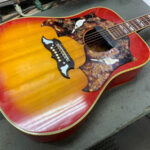 Beginner Guitar Chords: Mastering All Essential Chords
Beginner Guitar Chords: Mastering All Essential Chords
For anyone starting their guitar journey, learning All Guitar Chords can feel like climbing a mountain. It’s almost a rite of passage to begin with the foundational open position chords, often affectionately known as “cowboy chords” or “campfire guitar chords.” These are your gateway to countless songs, the building blocks for strumming along to classics like Red River Valley or Wabash Cannonball around a crackling campfire. The satisfaction of playing these simple chords while others sing along is a uniquely rewarding experience for any guitarist.
Explore my music page to listen to my recordings of Red River Valley, Wabash Cannonball, and other timeless tunes.
Beyond campfire singalongs, mastering all guitar chords in their basic forms unlocks a vast repertoire of popular music across genres – from rock and country to folk and beyond. These chords are the versatile keys to playing thousands upon thousands of songs.
Understanding String Dynamics Across All Guitar Chords
When first learning all guitar chords, especially chords like the D chord, beginners often fall into the trap of strumming all six strings with every chord. While enthusiasm is admirable, you’ll quickly discover that some chords simply don’t sound their best when every string is played.
The D chord, in its common voicing, perfectly illustrates this point. Ideally, a D chord is strummed using only the top four strings. This is because the D string itself serves as the root note, the foundational bass note of the chord. Strumming all six strings can muddy the sound and detract from the intended clarity of the D chord.
This selective strumming can initially make the D chord feel “thinner” or less impactful compared to other basic chords. Omitting the lower bass strings can create a sense of something missing, particularly when you’re used to the fuller sound of strumming all strings.
The Impact of Chord Voicing on Your Playing and Songwriting
The perceived “weakness” of the D chord, stemming from its typical voicing and string selection, can subtly influence a guitarist’s playing and even their songwriting choices. Personally, the feeling of the D chord being less sonically robust led me to, at least initially, avoid composing songs in the key of D. The thinner root chord sound didn’t appeal to my ear as much as the fuller sounds of other keys.
This early impression even shaped my playing habits. I developed a preference for a different voicing of the D7 chord, one that felt stronger and more resonant, and it remains my preferred form to this day. Understanding how the voicing of all guitar chords affects their sonic character is a crucial step in developing a nuanced playing style.
Overcoming the “Strum All Strings” Habit with Basic Guitar Chords
The tendency to strum “as many strings as possible” is a common syndrome among beginner guitarists learning all guitar chords. It’s a natural inclination, born from a desire to create a big, full sound right from the outset. When you’re just starting out, controlling your strumming hand to selectively hit strings is a skill that takes time and practice to develop.
Furthermore, the instinct to strum every string comes from a good place – wanting your guitar to sound rich and powerful. The logic seems straightforward: more strings strummed equals a bigger, fuller sound. However, mastering all guitar chords and becoming a more dynamic player involves understanding when not to strum every string.
Dynamics and Dynamic Range: The Soul of Guitar Music
The key realization for any guitarist, especially when learning all guitar chords, is that constantly strumming all strings is rarely the optimal approach. In fact, it can often detract from the musicality and interest of your playing. This principle applies not just to complex chords but even to the most basic guitar chords in your repertoire.
Even when playing full-bodied chords like E or G, which utilize all six strings, strategically strumming fewer strings at times can dramatically enhance your playing. The magic lies in dynamics. As the famous quote, often attributed to Mozart or Debussy, suggests: “It’s not the notes you play, it’s the silence between the notes.” This concept extends to the volume and intensity with which you play those notes.
Dynamics, in musical terms, refers to the variation in volume throughout a piece of music. The difference between the softest and loudest moments defines a piece’s dynamic range. Think of it like the ebb and flow of energy in music. A piece with a wide dynamic range is engaging and captivating because it takes you on a sonic journey.
Consider the impact of dynamics in different genres. Heavy metal or punk music, often characterized by a relentless, full-volume approach, can become tiring to listen to for extended periods. This is because their intentionally narrow dynamic range, essentially “volume at 11” from start to finish, lacks the ebb and flow that keeps the listener engaged. While impactful in short bursts, the lack of dynamic variation can lead to listener fatigue.
Dynamics as the Art of Musical Subtlety in All Guitar Chords
Beyond genres that intentionally minimize dynamics, most music thrives on a wider dynamic range. Crucially, dynamics aren’t just about the overall loudest and quietest parts of a song. Every single moment within a song can possess its own internal dynamics, adding depth and interest to your performance, regardless of whether you’re playing complex or basic guitar chords.
Whether you are tackling advanced chord voicings or practicing all guitar chords in their simplest forms, incorporating dynamics into your technique will always elevate your playing. It’s what transforms playing from simply hitting notes to crafting musical expression.
So, how do you inject dynamics into your guitar playing? Many techniques contribute, but one fundamental aspect is returning to the idea of not always strumming all six strings. Learning to “lay back” and play more quietly at times is essential, and controlling the number of strings you strum is a powerful tool for achieving this subtlety.
Strumming Patterns with Dynamics: Breathing Life into Basic Guitar Chords
A highly effective and versatile strumming pattern in common 4/4 time (assuming you’re using a pick or plectrum) provides a framework for incorporating dynamics:
1: Down strum (louder)
1 and: Skip (silence)
2: Down strum (medium volume)
2 and: Up strum (softer)
3: Skip (silence)
3 and: Up strum (softest)
4: Down strum (medium volume)
4 and: Up strum (softer)
This pattern, repeated throughout a song, is applicable to countless songs in 4/4 time. However, if you strum all strings with equal intensity on every down and up stroke, your playing will sound mechanical, clumsy, and, frankly, amateurish. The key is to introduce variation and intention into each strum.
Selective String Strumming for Dynamic Chord Voicing
Explaining the nuances of selective string strumming is challenging as there are no rigid rules. The ideal string combination varies depending on the song and the desired feel. However, as a general guideline, aim to strum more strings, emphasizing the lower strings, on your downstrokes. Conversely, on upstrokes, focus on hitting fewer strings, targeting the higher strings.
Experiment with this technique using the E chord, often considered the fullest sounding of all guitar chords. All six strings are part of the E chord, and three are open strings, including the low E string, the lowest note in standard tuning. This combination creates a rich, resonant chord that sounds fantastic when all strings are strummed.
However, continuously strumming all six strings of an E chord, with equal force on every stroke, quickly becomes monotonous. While initially powerful, the sound loses its impact due to the lack of dynamic variation. It shifts from powerful to simply loud, and potentially irritating.
Now, try the nuanced technique. Using the strumming pattern above, vary the number of strings you hit. For the “1” count of each measure, reduce the strum to just the low E string. Effectively, on the downbeat, you’re playing a single bass note rather than the full chord.
The Power of a Whisper: Dynamics in Musical Expression
Notice how that single low E note, played quietly, can seem to possess more impact than the full E chord? This is the essence of dynamics. It’s akin to whispering in a crowded room. Speaking at a normal volume might get lost in the background noise, but a whisper, by virtue of its contrast, can command attention and create intrigue.
Similarly, that lone bass note in your strumming pattern captures the listener’s ear. They may not consciously register it, but it creates a subtle shift in dynamics that keeps them engaged. This quiet moment grounds the music and sets the stage for the fuller chord that follows on the “2” count.
By incorporating these dynamic variations, every measure of your song gains depth and interest. Your playing becomes more comfortable and enjoyable to listen to, far more captivating than a static, undifferentiated sound. Maintaining these dynamics as you move through all guitar chords in a song is crucial for holding your audience’s attention. Dynamics are the secret ingredient for transforming even the most basic guitar chords into engaging and expressive musical phrases.
Building Dynamics into Your Basic Guitar Chords Now
For beginner guitarists learning all guitar chords, incorporating dynamics is the single most impactful step you can take to immediately improve your playing. Few techniques offer such a dramatic and instant boost in the quality of your guitar sound.
Stop strumming every string with equal force on every chord right now! Become selective. Tease your listener with a hint of the chord, perhaps just a bass note, on one beat, before unleashing the full chord on the next strum, then pulling back again on the subsequent upstroke.
Make developing this dynamic approach your priority. It’s one of the most critical foundational skills for any guitarist. Without a strong sense of dynamics, even advanced techniques and complex chord voicings can sound flat and uninspired.
Conversely, with dynamics as your primary tool, you can use even the simplest, most “boring” basic guitar chords to captivate your audience. Master dynamics first. Then delve into more advanced chords and techniques. These advanced skills will resonate far more powerfully with your listeners when you naturally integrate your refined sense of dynamics into your playing.
Conclusion: Dynamics Bring All Guitar Chords to Life
Dynamics are paramount to the quality and expressiveness of your guitar playing. Even all guitar chords, in their most basic forms, can become vibrant and engaging when you infuse your strumming with dynamic variation.
Remember, you don’t need to strum every string of every chord, all the time. In fact, sometimes, intentionally strumming fewer strings is the key to unlocking a richer, more dynamic sound. Embrace selective strumming as a fundamental technique for adding depth and nuance to your playing, and watch as all guitar chords come alive in your hands.


